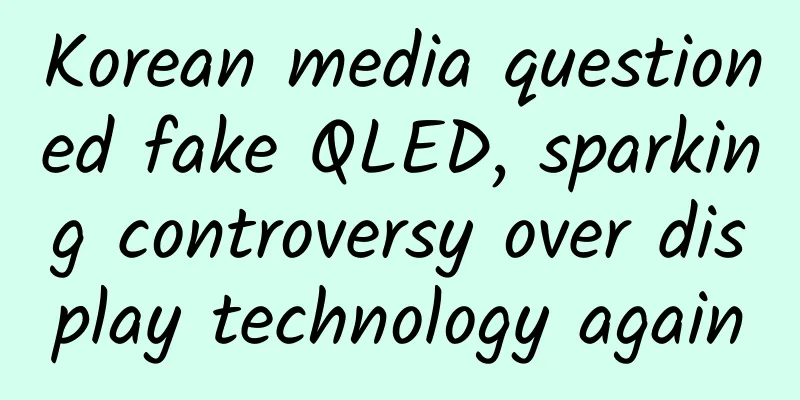Korean media questioned fake QLED, sparking controversy over display technology again

|
Recently, a report from South Korean media has sparked controversy and discussion about QLED TVs worldwide. According to South Korean KBS News, Chang Hee Lee, director of the Organic Semiconductor Laboratory at Seoul National University, questioned the current QLED TVs. The main question is whether the QLED TVs currently on the market are real QLEDs or "fake QLEDs." South Korea’s KBS News reported: South Korean experts question the current QLED naming is unreasonable In the past few decades, when the home appliance industry is about to transition to the next generation of technology, some ambiguous and confusing technology and concept packaging often appear. This kind of concept packaging is not new in the home appliance industry. For example, when mobile phone 3G was just becoming known to consumers, a company launched a "3G" water heater, which was actually 3 tubes (the first letter of Guan); for example, when smart home appliances were just beginning to emerge, appliances that only added a wifi module and could be controlled by a mobile phone APP were called "smart". As a result, the industry had to use a term to distinguish these early "smart" home appliances: pseudo-smart. There were also high-definition, ultra-high-definition, and full-high-definition TVs back then, and all kinds of "high-definition" confused consumers. The Korean media questioned the QLED technology. QLED itself is a future display technology. The current display technology is passive light-emitting, while the future display technology must be active light-emitting technology or self-luminous technology, such as OLED, which has commercial capabilities, and QLED, which is being developed in the laboratory. So are the QLED TVs currently on the market truly QLED TVs? An online search reveals that the QLED TVs that have been launched, although called "QLED", actually have a small font stating that they are "photoluminescent quantum dot TVs". For consumers, quantum dots may be something they have heard of, but light-induced is something that is completely confusing. Even if you search online, you still can’t figure out what it is. But “light-induced” is the key. There are two types of TVs that can be called quantum dot TVs. One is actively luminous, called electroluminescence, which is the real next-generation display technology, called QLED; the other is passively luminous, called photoluminescence, called QD-LCD. Compared with traditional LCD TVs, photoluminescent quantum dot technology adds new nanocrystal semiconductor quantum dot materials to QD-LCD, further improving the luminous efficiency of the backlight source and significantly improving the peak brightness of the screen display, but in essence it is still a color TV product using liquid crystal technology. The real QLED TV is still waiting to be perfected in the laboratory. The QLED TVs currently on the market simply cover the liquid crystal with a layer of quantum dot film. The reason why QLED cannot be commercialized is that the development time is too short, the industrial chain is immature, and the industrialization, especially the industrialization of large-screen products, cannot meet the requirements; more importantly, the best QLED screen can only last for 14,000 hours (1.6 years), which is far from enough for large screens, especially TV products. Who would buy a TV that can only be used for more than a year? QLED technology has technical difficulties such as poor reliability, low efficiency, unstable life of blue components, and difficulty in solution process research and development. It will take at least 10 years to overcome and apply it on a large scale. However, the reality facing the color TV industry is that, in the current situation of fierce competition and constant innovation, how should display technology develop? As a result, the color TV industry has triggered a dispute over color TV technology. There are currently two development directions, one is photoluminescent quantum dots, and the other is the pure color hard screen technology using Nano Cell (nano dots), which is also known as the most advanced color enhancement technology. For example, at the Shanghai Home Expo in March this year, LG, a global leader in display technology, exhibited a large-size solid-color hard-screen product and compared it with a pseudo "QLED TV" from another well-known Korean brand. First of all, in terms of color performance, the "pure color hard screen" TV uses a uniform nanoparticle film (human hair is 80,000 to 100,000 nanometers), while the current QLED technology adds a quantum dot film composed of 2~10 micrometers of uneven particles to the liquid crystal technology. In contrast, these nanoparticles are smaller than quantum dots and produce more delicate and accurate colors. The pure color hard screen absorbs excess light wavelengths and improves the purity of the three primary colors displayed on the screen. Compared with other screens, the pure color hard screen can project more rich colors. Pure means the closest to reality, which is exactly the characteristic of nano dots. In addition, the pure color hard screen technology makes the TV viewing angle wider and the picture more stable. It is understood that the color difference of traditional screens will be very obvious when the viewing angle is greater than 30 degrees, while the pure color hard screen still has no color difference when the viewing angle reaches 60 degrees, maintaining 100% high color gamut, forming the most realistic image. This is mainly because the pure color hard screen technology can enhance the color consistency when off-axis, eliminating the worry of color distortion caused by changes in viewing angle. Comparison of viewing angles between TVs using pure color hard screen technology and traditional TVs (pseudo QLED TVs) exhibited at the Shanghai Home Expo Comparison of viewing angles between pure color hard screen and traditional screen The essential difference between a good TV and an ordinary TV is that the picture quality and color are better no matter what angle you look at it from. If you spend a lot of money to buy a TV, but you can't see the best color most of the time, do you think the money is worth it? As a winner of Toutiao's Qingyun Plan and Baijiahao's Bai+ Plan, the 2019 Baidu Digital Author of the Year, the Baijiahao's Most Popular Author in the Technology Field, the 2019 Sogou Technology and Culture Author, and the 2021 Baijiahao Quarterly Influential Creator, he has won many awards, including the 2013 Sohu Best Industry Media Person, the 2015 China New Media Entrepreneurship Competition Beijing Third Place, the 2015 Guangmang Experience Award, the 2015 China New Media Entrepreneurship Competition Finals Third Place, and the 2018 Baidu Dynamic Annual Powerful Celebrity. |
<<: "Transformers" wants to challenge Toyota's "Earth-1". Can it create a miracle?
>>: Is Li Bin's NIO going to abandon JAC and join GAC in a cooperation worth 1.28 billion?
Recommend
How to create a breadcrumb navigation? How to modify the Robin breadcrumb navigation?
Each theme template has its own differences. The ...
Understand futures first, then you will know how Bank of China lost money!
This article was first published by Hunzhi (WeCha...
I used to be a chemist. After 9 months of self-taught programming, I became a software engineer with an annual salary of 6 figures
Editor's note: Whether in the near or long te...
In 2023, China's space program will accomplish these major tasks
In 2022, China's space industry experienced a...
Zheng Duoyan's 6-week aerobics weight loss plan
Zheng Duoyan's 6-week aerobics weight loss pl...
6 marketing strategies that work well on the Internet and in physical stores, with 18 real cases included!
Without further ado, let’s get straight to the po...
Facebook dominates mobile! Daily active users reach 800 million
[[132525]] As Internet users around the world swi...
The "cold" war in the office: Girls are more likely to feel that the air conditioner is too cold
Review expert: Peng Guoqiu, deputy chief physicia...
A universal event planning solution
There is actually no shortcut to planning an even...
Are movies adapted from novels necessarily inferior to the originals? Here are some counter-examples!
In 1999, young Neo in "The Matrix" face...
It’s the peak of the new semester, beware of this virus! Many places have issued warnings!
Recently, the COVID-19 epidemic situation in Chin...
Are TVs at CES getting too complicated?
On January 7, the 2015 International Consumer Ele...
Plant a tree, and your family won’t have to pay electricity bills for the rest of their lives… Is there such a good thing?!
Image source: sratup One day in 2011, French engi...
How much does it cost to join the Nantong Photo Mini Program?
How much does it cost to join the Nantong Photo M...









